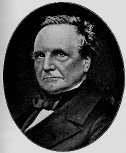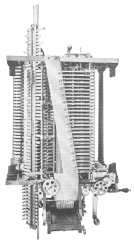
Charles Babbage
1791-1871
English eccentric and inventor

part of the analytical engine
Charles Babbage1791-1871English eccentric and inventor |
part of the analytical engine |
Possibly the earliest attempt at designing a computer in the modern sense of the word (the word "computer" used to mean a person who did computations) was eccentric English inventor Charles Babbage's analytical engine. The analytical engine had many elements of a modern computer -- a processing unit (which he called the "mill"), programs stored as numbers, data brought into the computer on punched cards, and printed output.
What made the analytical engine such a feat of engineering was that it was built before the discovery of electronics, and was entirely mechanical. Its memory consisted of gears, while the processing unit, or mill, consisted of cams, clutches, cranks and gears.
The analytical engine project grew out of an earlier, less ambitious project, the difference engine. Where the difference engine did a relatively fixed computation, the analytical engine was designed to be a truly general computational device. The use of cards to record a program was inspired by the Jacquard loom, in which punched cards controlled the pattern being woven.
Babbage began his difference engine project in around 1822, and the British government abandoned the project in 1842. Meanwhile, Babbage began the analytical engine project in 1833, and was not to complete it by the time of his death in 1871.
In some ways, the project was ahead of its time -- despite the apparently primitive construction using cogs, cams, clutches, etc. Babbage had to invent new technologies for machine tools to obtain the accuracy he desired.
Babbage's inventive genius did not stop at computational devices. Some credit him with the inventions of government funded research, as well as the major cost overrun and the uncompleted project.
The major source for material on this page is Brian Randell (ed.). The Origins of Digital Computers (2nd ed.), Springer, Berlin, 1975.
| Memories are Made of This 17:30 Thurs 12 September 1996 SHB5, Senate House, University of the Witwatersrand, Johannesburg, South Africa |
